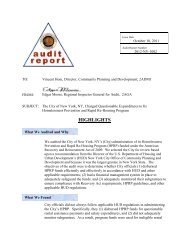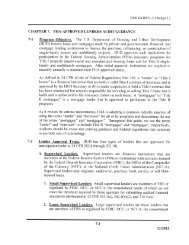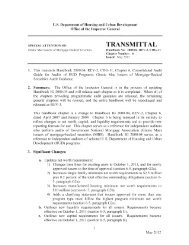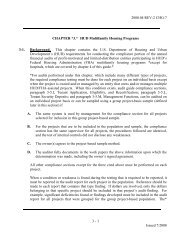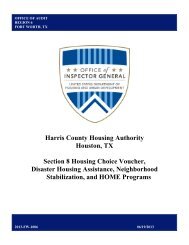Insured Development Cost Certification Audit Guidance - Hud-Oig
Insured Development Cost Certification Audit Guidance - Hud-Oig
Insured Development Cost Certification Audit Guidance - Hud-Oig
Create successful ePaper yourself
Turn your PDF publications into a flip-book with our unique Google optimized e-Paper software.
2000.04 REV-2 CHG-5<br />
CHAPTER 5.<br />
DEVELOPMENT COST CERTIFICATION AUDIT GUIDANCE<br />
5-1 Program Objective. Multifamily projects are an integral part of the U.S. Department<br />
of Housing and Urban <strong>Development</strong>’s (HUD) housing programs, which have the<br />
objectives of providing decent, safe, affordable, and sanitary housing for low- and<br />
moderate-income families. *The loans for the multifamily projects are insured through<br />
the multifamily project loan program. *HUD- Federal Housing Administration (FHA)<br />
insures lenders against losses on mortgages providing the financing for the construction<br />
or rehabilitation of multifamily rental projects. For the insured loan program, the<br />
project is ordinarily HUD’s only source for loss recovery in the event of a foreclosure.<br />
Therefore, it is essential that collateral value be commensurate with the insurance risk.<br />
*This handbook chapter is intended for use by for-profit mortgagors to provide audit<br />
guidance for the audit of development cost certifications. However, this chapter can<br />
also be used to provide audit guidance to not-for-profit mortgagors for their audits of<br />
development cost certifications as provided for under OMB Circular A-133, paragraph<br />
235(a), program-specific audit guide available.*<br />
5-2 Program Procedures. *The cost certification is the basis for HUD’s determination of<br />
the project’s actual development cost and/or the maximum insurable mortgage, which<br />
is necessary before the project may proceed to final formal endorsement, a critical<br />
factor to multifamily projects. The effective date for the determination of actual costs<br />
is usually the date the HUD inspector signs the final HUD representative’s trip report<br />
(Form HUD-95379), provided that the trip report is subsequently endorsed by the<br />
construction manager. Construction must be completed, except for acceptable items of<br />
delayed completion (Multifamily Accelerated Processing Guide (MAP Guide), chapter<br />
14, section 14.7). The HUD field office manager has the option to set an earlier date to<br />
halt the unnecessary accumulation of certain costs. A reasonable time is set for<br />
submission of the cost certification, which must be in the HUD field office 30 days<br />
before final endorsement/closing. Typically, the cost certification is prepared and<br />
submitted within 60 to 90 days after the cost cutoff date. The cost certification is<br />
submitted in hard-copy format to the HUD field office. The cost certification is not<br />
submitted electronically to HUD’s Real Estate Assessment Center (REAC).<br />
The owner’s first operating audit will cover the period beginning on the day after the<br />
cost certification cutoff through the owner’s fiscal year end. All operating audits must<br />
be prepared in accordance with chapter 3, HUD Multifamily Housing Programs, of this<br />
guide and must be submitted to REAC electronically via the Financial Assessment<br />
Subsystem (FASS) within 90 days of the owner’s fiscal year end.*<br />
5-1<br />
3/2007
2000.04 REV-2 CHG-5<br />
*On occasion, the owner may be responsible for submitting financial statements with<br />
reporting periods of less than 12 months (referred to as a stub period). If that reporting<br />
period is less than 90 days, upon request, HUD may approve the deferment of the<br />
owner’s reporting of the stub period and add that period to the next full year financial<br />
statements (Submission and Review Requirements & REMS Critical Data Fields for<br />
Annual Financial Statements, attachment 2, paragraph C).*<br />
HUD expects completed certifications, fully documented and in the prescribed format,<br />
to be submitted by the mortgagor. If an identity of interest exists between the<br />
mortgagor and the contractor or if a cost plus type construction contract was used, the<br />
contractor is also required to submit a cost certification. Similarly, if an identity of<br />
interest exists between a subcontractor, materials supplier, or equipment lessor, a cost<br />
certification must be submitted. Additional support for any cost items questioned by<br />
HUD is expected within 15 days of the request. Extended delays in the cost<br />
certification process, which postpone final endorsement, can cause substantial harm to<br />
the project’s viability and eventual success.<br />
5-3 Reference Material. *One of the primary sources of guidance for cost certifications is<br />
the MAP Guide. In particular, chapter 14 contains the most current guidance issued by<br />
HUD regarding the cost certification process. The following is the reference material<br />
that was in effect at the time this handbook chapter was issued. It is the auditor’s<br />
responsibility to use the appropriate reference material that was in effect during the<br />
period covered by the audit.<br />
Throughout this chapter, reference is made to handbooks using the base handbook<br />
number without the revision number (i.e., REV-1, REV-6, etc.). This will enable<br />
periodic updates to paragraph 5-3 rather than revising the references in the entire<br />
handbook/chapter. Also, the auditor should ensure that the updated reference is used<br />
for performing the audit. If reference to the handbook is needed in the audit report, the<br />
auditor should ensure that the entire updated reference, including the revision number,<br />
is used.*<br />
Document<br />
HUD Handbook 4571.5<br />
*HUD Handbook 4571.4<br />
HUD Handbook 4571.1, REV-2<br />
Title<br />
Supportive Housing for Elderly, Conditional<br />
Commitment - Final Closing<br />
Supportive Housing for Persons with Disabilities,<br />
Conditional Commitment - Final Closing*<br />
Section 202 Direct Loan Program for Housing for<br />
the Elderly and/or Handicapped<br />
5-2<br />
3/2007
2000.04 REV-2 CHG-5<br />
Document<br />
HUD Handbook 4470.2, REV-1<br />
HUD Handbook 4470.1, REV-2<br />
HUD Handbook 4450.1, REV-1<br />
*HUD Handbook 4435.1, REV-1<br />
*Notice H 96-102<br />
*Mortgagee Letter 04-41<br />
*Document does not have a HUD<br />
number or transmittal reference<br />
Title<br />
<strong>Cost</strong> <strong>Certification</strong> Guide for Mortgagors and<br />
Contractors of HUD-<strong>Insured</strong> and Section 202/811<br />
Multifamily Projects<br />
Mortgage Credit Analysis for Project Mortgage<br />
Insurance, Section 207<br />
<strong>Cost</strong> Estimation for Project Mortgage Insurance<br />
Project Construction and Servicing Before Final<br />
Closing*<br />
Redesigned Section 202 Supportive Housing for<br />
the Elderly and Section 811 Supportive Housing<br />
for Persons with Disabilities Programs - Firm<br />
Commitment*<br />
Multifamily Accelerated Processing Guide<br />
Revised March 15, 2002 (1)*<br />
Submission and Review Requirements & REMS<br />
Critical Data Fields for Annual Financial<br />
Statements (2)*<br />
*<br />
(1) = This document is not a numbered document under the HUD<br />
unified issuance system and can be obtained by using the following<br />
link:<br />
http://www.hud.gov/offices/hsg/mfh/map/mapguide/mapguide.cfm<br />
(2) = This document is not a numbered document under the HUD<br />
unified issuance system and can be obtained by using the following<br />
link:<br />
http://www.hud.gov/offices/reac/products/PDFs/finl_memo_2004_1a.pdf<br />
If the program participant does not have this reference material, it may be obtained by<br />
accessing HUD’s Client Information and Policy System (HUDCLIPS) at the following<br />
Web site:<br />
http://www.hudclips.org/cgi/index.cgi<br />
*<br />
5-3<br />
3/2007
2000.04 REV-2 CHG-5<br />
*or may be ordered from HUD’s Direct Distribution System by telephone at (800) 767-<br />
7468; in a letter addressed to HUD, Customer Service Center, Room B-100, 451<br />
Seventh Street, SW, Washington, DC 20410; or by fax at (202) 708-2313.<br />
5-4 Reporting Requirements.<br />
Regulations at 24 CFR [Code of Federal Regulations] 200.95, 200.96, 200.97, and<br />
891.545 require mortgagors/borrowers to submit certificates of actual cost before final<br />
endorsement of the insured loans or disbursement of loan proceeds or capital advances<br />
for the project. Mortgagors and contractors are required to determine costs in<br />
accordance with Mortgage Credit Analysis for Project Mortgage Insurance, HUD<br />
Handbook 4470.1; <strong>Cost</strong> <strong>Certification</strong> Guide for Mortgagors and Contractors of HUD-<br />
<strong>Insured</strong> Multifamily Projects, HUD Handbook 4470.2; Chapter 5, Supportive Housing<br />
for Persons with Disabilities, Conditional Commitment - Final Closing, HUD<br />
Handbook 4571.4; Chapter 5, Supportive Housing for Elderly – Conditional<br />
Commitment Final Closing, HUD Handbook 4571.5; Section VI of HUD Notice H 96-<br />
102; and chapter 14 of the MAP Guide. The MAP Guide, as well as HUD Handbook<br />
4470.2, contains the requirement for who among the mortgagor, general contractor,<br />
subcontractors, and suppliers must provide cost certifications, guidance on eligible<br />
costs, necessary financial statements which must accompany the certificate of actual<br />
cost, and details concerning the mortgagor’s Form HUD-92330 and contractor’s Form<br />
HUD-92330-A.<br />
Mortgagors and contractors must prepare certification of actual cost and submit the<br />
required financial statements. The mortgagor’s certificate of actual cost (Form HUD-<br />
92330) shall be submitted after the cost certification cutoff date. It is submitted upon<br />
completion of the physical improvements to the satisfaction of HUD and before<br />
endorsement. The certificate shall show the actual cost to the mortgagor after<br />
deduction of any kickbacks, rebates, trade discounts, or other similar payments to the<br />
mortgagor or officers, stockholders, or partners. Those documents must be prepared in<br />
conformity with the basis of accounting and reporting procedures prescribed by HUD,<br />
which is a comprehensive basis of accounting other than generally accepted accounting<br />
principles. The owner must sign and date Form HUD-92330, and the contractor must<br />
sign and date Form HUD-92330-A, in the areas provided on the forms, by no later than<br />
the date of the audit opinion.<br />
A. Mortgagor Submission Requirements. Mortgagors must certify for all projects<br />
except 207/223(f) refinances in which the insured value is 80 percent or less of<br />
value. They are to submit the mortgagor’s cost certification (Form HUD-92330)<br />
supported by an accountant’s opinion, an audited balance sheet of the mortgage<br />
entity as of the cutoff date, and an audited operating statement if occupancy*<br />
5-4<br />
3/2007
2000.04 REV-2 CHG-5<br />
*occurred before the cost certification cutoff date. An audit report with the<br />
certification by an independent certified public accountant or an independent public<br />
accountant must accompany the mortgagor’s certification of actual cost, the audited<br />
balance sheet and operating statement of the mortgagor, and the contractor’s<br />
certificate of actual cost (Form HUD-92330A). The period covered by the<br />
operating statement is from the beginning of marketing and rent-up activities to the<br />
cutoff date. <strong>Cost</strong>s reported on Form HUD-92330 support certain entries on the<br />
required financial statements. If there were more than three months between the<br />
cost cutoff date and the start of amortization, the mortgagor must submit a<br />
supplemental operating statement.<br />
The certificate of actual cost, auditor’s reports, and required financial statements are<br />
to be submitted to the applicable HUD field office.<br />
The auditor must conduct the audit under both the auditing standards generally<br />
accepted in the United States of America and the generally accepted government<br />
auditing standards (GAGAS) issued by the comptroller general of the United States<br />
(MAP Guide chapter 14, section 14.11, paragraph 6 and chapter 2 of this guide).<br />
Illustrative reporting information on the cost certification is provided in paragraph<br />
5-7 of this chapter.<br />
B. Contractor Submission Requirements: Contractors must certify when<br />
(1) The contractor has an identity of interest with the mortgagor and/or<br />
(2) The contractor used the Construction Contract <strong>Cost</strong> Plus, Form HUD-<br />
92442-A.<br />
A subcontractor at any tier, equipment lessor, material supplier, and manufacturer<br />
of industrialized housing must certify when<br />
(3) The total of all subcontracts, purchases, and leases is more than .5 percent of<br />
the mortgage and<br />
(4) An identity of interest exists or comes into being between such<br />
subcontractor, equipment lessor, material supplier, or manufacturer of<br />
industrialized housing and either the mortgagor or the contractor if the<br />
contractor must certify.<br />
The contractor is to submit a certificate of actual cost (Form HUD-92330A),<br />
supported by an accountant’s opinion, to the mortgagor. A certification by an<br />
independent certified public accountant or an independent public accountant must*<br />
5-5<br />
3/2007
2000.04 REV-2 CHG-5<br />
*accompany the contractor’s certification of actual cost. The auditor must use<br />
GAGAS in auditing the cost certification. No other financial statements or reports<br />
of the contractor are required to be submitted. The contractor should submit the<br />
reporting package to the mortgagor for inclusion in the mortgagor’s submission to<br />
the appropriate HUD field office.*<br />
5-5 Compliance Requirements and <strong>Audit</strong> Area.<br />
A. Federal Financial Reports.<br />
1. Compliance Requirement. Projects with a HUD - insured mortgage or<br />
receiving HUD direct loans or capital advances are required to ensure that<br />
financial status reports contain reliable financial data and are presented in<br />
accordance with the terms of applicable agreements between the entity and<br />
HUD. The individual agreements contain the specific reporting requirements<br />
that the entity is to follow.<br />
2. Suggested <strong>Audit</strong> Procedures.<br />
a. Identify all required financial reports by inquiry of the owner/manager.<br />
b. Obtain an understanding of the auditee’s procedures for preparing and<br />
reviewing the financial reports.<br />
c. Select a sample of financial reports, other than those which are included in<br />
the audited financial statements, and determine that the reports selected are<br />
prepared in accordance with HUD instructions.<br />
d. For the sample, trace significant data to supporting documentation; i.e.,<br />
worksheets, ledgers, etc. Report all material differences between financial<br />
reports and project records.<br />
e. Review adjustments made to the general ledger accounts affecting HUDassisted<br />
activity and evaluate for propriety.<br />
B. Accounting System.<br />
1. Compliance Requirement. Mortgagors and contractors involved in projects<br />
that are to receive HUD-insured loans and capital advances have agreed to<br />
maintain adequate records for the purpose of determining the eligible costs<br />
associated with the projects (HUD Handbook 4470.2, chapter 3).<br />
5-6<br />
3/2007
2000.04 REV-2 CHG-5<br />
2. Suggested <strong>Audit</strong> Procedures.<br />
a. Obtain an understanding of the mortgagor’s and contractor’s accounting<br />
system for identifying actual costs associated with a given project. Test the<br />
system to determine whether it identifies the costs to be reported on the<br />
Form HUD-92330 on an individual project basis.<br />
b. Review Form HUD-92330 for completeness and support by the accounting<br />
records.<br />
c. Trace significant data from Form HUD-92330 to supporting documentation;<br />
i.e., worksheets, ledgers, etc. Report all material differences between the<br />
amounts reported on the Form HUD-92330 and the supporting documents.<br />
C. Cutoff Timing and Eligibility of <strong>Cost</strong>s.<br />
1. Compliance Requirement. As a general rule, only the costs which have been<br />
or will be paid in cash within 45 days after the date of final endorsement or<br />
closing or which are escrowed with the mortgagee are eligible for inclusion on<br />
the mortgagor’s or contractor’s certificates of actual cost.<br />
For projects with insured mortgages, the mortgagor determines the cost cutoff<br />
date for the actual cost of the interest, taxes, insurance, and mortgage insurance<br />
premium as well as soft costs and special escrow items. This date may, at the<br />
earliest, be the same date as the final completion date and, at the latest, be a date<br />
60 days after the final completion date or, at the mortgagor’s option, any date in<br />
between. The date chosen as the cutoff date and the date to which the operating<br />
statement and balance sheet are computed must be the same. *The mortgagor,<br />
general contractor, and mortgagee will be notified in writing of the final<br />
completion date (MAP Guide chapter 14, section 14.7).*<br />
The final completion date is the date on which the HUD inspector signs the final<br />
HUD Representative’s Trip Report, Form HUD-95379, showing substantial<br />
completion. The field construction manager must properly endorse this form.<br />
HUD notifies the mortgagor/borrower, the general contractor, and the<br />
mortgagee of the date of completion in writing. This date becomes the basis for<br />
establishing the cutoff date for insured projects, direct loan projects, and capital<br />
advance projects (HUD Handbook 4470.2, chapter 1, *and MAP Guide, chapter<br />
14)*.<br />
5-7<br />
3/2007
2000.04 REV-2 CHG-5<br />
Eligible costs are those costs of the project construction and certain fees paid in<br />
cash or such costs that will be paid in cash within 45 days of final endorsement.<br />
HUD Handbooks 4470.1; 4450.1; and 4470.2, chapter 2, contain information on<br />
allowable costs to be reported on Form HUD-92330 and the ways in which<br />
costs are to be adjusted for items considered to be a recovery of costs.<br />
2. Suggested <strong>Audit</strong> Procedures.<br />
a. Review the trip report, Form HUD-95379, or similar notification to<br />
determine the final completion date.<br />
b. Based on the completion date, the mortgagor/borrower determines the<br />
project’s cutoff date for time-sensitive expenses, such as interest, taxes,<br />
insurance, mortgage, and property insurance premiums, as well as soft costs<br />
and special escrow items. Review these costs/charges to determine that<br />
none were incurred after the cutoff date *and that the costs are proper<br />
charges to the project.*<br />
c. Review the other amounts claimed on Form HUD-92330 to determine that<br />
the claims represent those expenses paid in cash or expected to be paid in<br />
cash within 45 days after final closing on behalf of the project. All amounts<br />
claimed should be net of any adjustments or recoveries of costs.<br />
D. Identity of Interest.<br />
1. Compliance Requirement. HUD Handbooks 4430.1; 4470.1; 4470.2, chapter<br />
3; and MAP Guide, chapter 14, Section 14.15, describe several situations, which<br />
constitute an identity of interest involving a mortgagor, a contractor, a<br />
subcontractor, or a materials supplier. When an identity of interest exists, the<br />
contractor must also submit a certificate of actual cost, or the party involved in<br />
the identity of interest is required to submit additional documentation as<br />
required by HUD Handbook 4470.2, chapter 3. The contractor is also required<br />
to submit a certificate of actual cost if a cost plus construction contract was<br />
used.<br />
2. Suggested <strong>Audit</strong> Procedures.<br />
a. Review mortgagor and project records such as contracts and vendor invoices<br />
to determine whether an identity of interest exists among any of the parties<br />
involved in the project, from mortgagors to contractors, suppliers, and<br />
equipment lessors. *Inquire to determine whether an identity-of-interest<br />
relationship exists.*<br />
5-8<br />
3/2007
2000.04 REV-2 CHG-5<br />
b. When an identity of interest exists, determine that the additional reporting<br />
requirements of HUD Handbook 4470.2 and MAP Guide, chapter 14, have<br />
been met.<br />
*<br />
5-6 <strong>Audit</strong> Finding Reporting.<br />
All material instances of noncompliance with any HUD requirement or regulation,<br />
deficiencies in internal control, fraud or illegal acts, or contract violations that were<br />
disclosed during the audit process must be reported as findings in the audit report. All<br />
nonmaterial instances of noncompliance, deficiencies in internal control, fraud or illegal<br />
acts, or contract violations disclosed during the audit process may be reported separately<br />
to management. Such reporting must be in writing in a management letter or other type<br />
of written auditor communication and must be mentioned in the independent auditor’s<br />
report, including the date of the management letter or other written communication.<br />
Noncompliance’s, deficiencies, or instances of violations that were corrected during the<br />
audit process, after the fiscal year under audit, or disclosed as a part of the audit process<br />
before the end of the fiscal year under audit and/or before the issuance of the audit report<br />
must be included in the report as resolved findings or in a management letter or other<br />
types of written auditor communication, depending on their materiality.<br />
A. Content of Finding.<br />
Findings are to be presented in accordance with the standards and requirements of<br />
the “Yellow Book.” A finding should be supported by sufficient, competent, and<br />
relevant evidence; be presented in a manner to promote adequate understanding of<br />
the matters reported; and provide convincing but fair presentations in proper<br />
perspective.<br />
Please refer to chapter 2 for the information that is to be included in a finding.<br />
B. Corrective Action in Process.<br />
Many times when auditees are presented with draft findings, they will start to take<br />
action to correct the deficient condition. When this action is underway and the<br />
auditor has completed his/her fieldwork, the auditee can include the action<br />
completed and the action remaining to be taken in the auditee’s comments and in<br />
the corrective action plan. Regardless of whether the auditee is in the process of<br />
correcting the finding, the auditor is to include the finding in the report with all<br />
required elements.*<br />
5-9<br />
3/2007
2000.04 REV-2 CHG-5<br />
C. *Corrective Action Completed.<br />
Many times when auditees are presented with draft findings, they will start to take<br />
action and complete that action, correcting the deficient condition before the<br />
completion of the fieldwork. When this occurs, the finding is still to be included in<br />
the audit report with all required elements. The action taken/completed should be<br />
included in the auditee’s comment section and should be validated by the auditor.<br />
The recommendation section should follow the auditee’s comment section, and the<br />
auditor should state whether he/she validated the action or not. In addition, the<br />
auditor could include any additional recommendations he/she believes necessary<br />
based on their validation of that action.<br />
If costs are involved and if those costs have been repaid, the auditor should validate<br />
that the auditee made the necessary adjustments to its books-of-account. The<br />
auditor’s certified statements should contain all necessary adjustments to the<br />
reported amounts, with appropriate notes, so that the certified costs of the project<br />
are accurately stated. Comments should also be included in the report in the “action<br />
taken” section of the finding. *<br />
5-10<br />
3/2007
2000.04 REV-2 CHG-5<br />
5-7 Illustrative Reporting. *These samples are for the Sample Company, which is a<br />
partnership. The wording is to be changed based on the type of ownership of the<br />
property.*<br />
Report of Independent Certified Public Accountants<br />
To the Partners<br />
Sample Company<br />
We have audited the mortgagor’s certificate of actual costs (Form HUD-92330),<br />
through [insert cutoff date, for example, April 30, 2010]; pertaining to the<br />
development of the Sample Company, Project No. [Insert project number]. We have<br />
also audited the [insert names of statements included in the report (financial<br />
statement)] as of [insert the cutoff date, for example, April 30, 2010], and the results<br />
of project operations for the period from [insert date, for example, August 28, 2008,<br />
which is the date of commencement of marketing and rent-up activities, etc.] through<br />
[insert the cutoff date, for example, April 30, 2010]. The Form HUD-92330 and the<br />
financial statements are the responsibility of the Sample Company’s management.<br />
Our responsibility is to express an opinion on the Form HUD-92330 and on the<br />
financial statements based on our audit.<br />
We conducted our audit in accordance with auditing standards generally accepted in<br />
the United States of America and the government auditing standards issued by the<br />
comptroller general of the United States. Those standards require that we plan and<br />
perform the audit to obtain reasonable assurance about whether the Form HUD-92330<br />
and the financial statements are free of material misstatement. An audit includes<br />
examining, on a test basis, evidence supporting the amounts and disclosures in the<br />
Form HUD-92330 and in the financial statements. An audit also includes assessing<br />
the accounting principles used and significant estimates made by management, as<br />
well as evaluating the overall financial statement presentation. We believe that our<br />
audit provides a reasonable basis for our opinion.<br />
As described in note [insert the note number], the certificate of actual cost (Form<br />
HUD-92330) and the project’s financial statements were prepared in conformity with<br />
the basis of accounting and reporting practices prescribed by the U.S. Department of<br />
Housing and Urban <strong>Development</strong> (HUD), which is a comprehensive basis of<br />
5-11<br />
3/2007
2000.04 REV-2 CHG-5<br />
accounting other than generally accepted accounting principles. Further, the<br />
accompanying financial statements represent the financial statements of the project.<br />
In our opinion, the mortgagor’s certificate of actual costs (Form HUD-92330) and the<br />
financial statements referred to above present fairly, in all material respects, the actual<br />
costs of the Sample Company, through [insert cutoff date, for example, April 30,<br />
2010]; the assets, liabilities, and project equity as of [insert cutoff date, for example,<br />
April 30, 2010]; and the results of project operations for the period from [insert date,<br />
for example August 28, 2008, which is the date of commencement of marketing and<br />
rent-up activities, etc.] through [insert cutoff date, for example, April 30, 2010], on<br />
the basis of accounting described in note [insert the note number].<br />
In accordance with government auditing standards,, we have also issued our report<br />
dated [date of report] on our consideration of the Sample Company’s internal control<br />
over financial reporting and on our tests of its compliance with certain provisions of<br />
laws, regulations, contracts, and grant agreements and other matters. The purpose of<br />
that report is to describe the scope of our testing of internal control over financial<br />
reporting and compliance and the results of that testing, and not to provide an opinion<br />
on the internal control over financial reporting or on compliance. That report is an<br />
integral part of an audit performed in accordance with government auditing standards<br />
and should be considered in assessing the results of our audit.<br />
This report is intended solely for the information and use of the board of directors and<br />
management of the Sample Company and HUD and is not intended to be and should<br />
not be used by anyone else other than these specified parties.<br />
`<br />
Certified Public Accountant Signature<br />
Date<br />
5-12<br />
3/2007
2000.04 REV-2 CHG-5<br />
Sample Company<br />
Project No. XXX-XXXXX<br />
Notes to Financial Statements<br />
Basis of Presentation<br />
Summary of Significant Accounting Policies<br />
The financial statements have been prepared in conformity with the accounting and<br />
reporting standards prescribed by the U.S. Department of Housing and Urban<br />
<strong>Development</strong> (HUD) in the <strong>Audit</strong> Guide for <strong>Audit</strong>ing <strong>Development</strong> <strong>Cost</strong>s of<br />
HUD-<strong>Insured</strong> Multifamily Projects. These standards differ in some respects from<br />
generally accepted accounting principles, and the financial statements reflect the<br />
following additional HUD accounting and reporting principles:<br />
a. <strong>Cost</strong>s are to be exclusive of kickbacks, rebates, or trade discounts.<br />
b. Financing charges are limited to the lesser of amounts actually paid or<br />
amounts approved by HUD on the mortgagee’s certificate. For this project,<br />
the financing charges are the amounts [insert comment that applies - actually<br />
paid or approved by HUD].<br />
c. The (insert actual name of statement; i.e., statement of rental operations)<br />
reflects the rental activity and operating expenses of the project beginning<br />
[insert date of commencement of marketing and rent-up activities, etc., for<br />
example, August 28, 2008]. The statement does not include depreciation and<br />
amortization expenses and certain other expenses, which are not incidental to<br />
the rental operation of the project.<br />
d. Project equity represents the difference between the funds received by the<br />
project from Sample Company and the costs incurred to develop the project,<br />
plus the income from the project. More detailed information on the<br />
determination of equity is contained in the MAP Guide, chapters 7, 12, and<br />
14. Further, partners’ (members’) (nonproject) obligations are classified as<br />
project equity. Partners’ (members’) equity is not intended to reflect the<br />
actual equity of the partnership because it may include partnership obligations<br />
and adjustments for the as-is value of land. The financial statements are not<br />
intended to represent those of the partnership.<br />
5-13<br />
3/2007
2000.04 REV-2 CHG-5<br />
Sample Company<br />
Project No. XXX-XXXXX<br />
Notes to Financial Statements<br />
Summary of Significant Accounting Policies<br />
Organization<br />
Sample Company is a limited partnership organized under the laws of the state of<br />
[Insert name of State], for the purpose of developing and operating a 203-unit project<br />
located in [location of project]. The partnership will operate under the provisions of<br />
Section 221(d) (4) of the National Housing Act, with mortgage insurance provided by<br />
the Federal Housing Administration (FHA) of the U.S. Department of Housing and<br />
Urban <strong>Development</strong>.<br />
The responsibility for management of the affairs of the partnership and the ongoing<br />
management of the Sample Company is vested with the general partners.<br />
Compensation for such services is as determined in the management agreement<br />
between the partners.<br />
*<br />
5-8 Technical Assistance Needed.<br />
The chief, Technical Support Division, Office of Multifamily Housing <strong>Development</strong>, is<br />
responsible for answering programmatic questions for the programs being audited using the<br />
procedures outlined in this chapter. Programmatic questions on audits performed using this<br />
chapter should be referred to that office, 202-708-0614, extension 2559.*<br />
5-14<br />
3/2007



